Related Research Articles
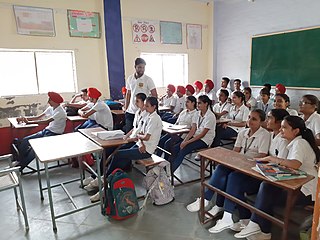
Education in India is primarily managed by state-run public education system, which fall under the command of the government at three levels: Central, state and local. Under various articles of the Indian Constitution and the Right of Children to Free and Compulsory Education Act, 2009, free and compulsory education is provided as a fundamental right to children aged 6 to 14. The approximate ratio of public schools to private schools in India is 7:5. Major policy initiatives in Indian education are numerous. Up until 1976, education policies and implementation were determined legally by each of India’s constitutional states. The 42nd amendment to the constitution in 1976 made education a ‘concurrent subject’. From this point on the central and state governments shared formal responsibility for funding and administration of education. In a country as large as India, now with 28 states and eight union territories, this means that the potential for variations between states in the policies, plans, programs and initiatives for elementary education is vast. Periodically, national policy frameworks are created to guide states in their creation of state-level programs and policies. State governments and local government bodies manage the majority of primary and upper primary schools and the number of government-managed elementary schools is growing. Simultaneously the number and proportion managed by private bodies is growing. In 2005-6 83.13% of schools offering elementary education were managed by government and 16.86% of schools were under private management. Of those schools managed privately, one third are ‘aided’ and two thirds are ‘unaided’. Enrolment in Grades 1-8 is shared between government and privately managed schools in the ratio 73:27. However in rural areas this ratio is higher (80:20) and in urban areas much lower (36:66).

Tripura is a state in northeastern India. The third-smallest state in the country, it covers 10,491.69 km2 (4,050.86 sq mi) and is bordered by Bangladesh to the north, south, and west, and the Indian states of Assam and Mizoram to the east. In 2011 the state had 3,671,032 residents, constituting 0.3% of the country's population.

Agartala is the capital city of the Indian state of Tripura, and is one of the largest cities in northeast India. The city is governed by the Agartala Municipal Corporation. The city is the seat of the Government of Tripura. It is located on the banks of the Haora River, near the Bangladesh border, about 90 kilometres (55 mi) east of Bangladesh's capital Dhaka and about 2,499 km (1,522 mi) from the national capital New Delhi. Agartala is being developed under the Smart Cities Mission, a flagship scheme of the Government of India.
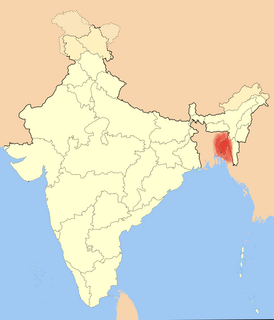
Kokborok is the main native language of the Tripuri people of the Indian state of Tripura and neighbouring areas of Bangladesh. Its name comes from kok meaning "verbal" and borok meaning "people" or "human". Kokborok or Tripuri is one of the ancient language of North East India.

Education in Bangladesh is overseen by the country's Ministry of Education. The Ministry of Primary and Mass Education is responsible for implementing policy for primary education and state-funded schools at a local level. In Bangladesh, all citizens must undertake ten years of compulsory education which consists of five years at primary school level and five years at high school level. Primary and secondary education is financed by the state and free of charge in public schools.

Maharaja Bir Bikram College or MBB College is a degree college of the Indian state of Tripura, imparting general education in the streams of Science, Commerce and Humanities. Established in 1947, it is the oldest college in the state of Tripura with a campus spread over 264 acres (107 ha). It is located approximately 3 km (1.9 mi) from the city center. The motto of the college is "Vidayamrtamasnute".

Udaipur, formerly known as Rangamati, is the third biggest city in the Indian state of Tripura. The city was a capital of the state during the reign of the Manikya Dynasty. This city is famous for the Tripura Sundari temple also known as Tripureswari temple which is one of the 51 Shakti pithas. It is a Municipal Council in Gomati district & also the headquarters of Gomati district. Udaipur is about 51 km from Agartala, the capital of Tripura.
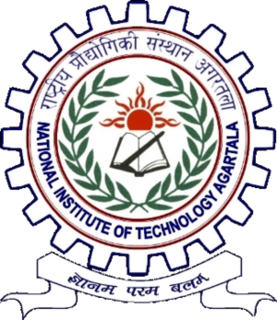
National Institute of Technology Agartala is a technology-oriented institute of higher education established by India's Ministry of Human Resource Development Government of India in Agartala, India. It was founded as Tripura Engineering College in 1965 and declared a National Institute of Technology (NIT) in 2006, thus being recognized as an Institute of National Importance.

Dharmanagar or (Dhôrmônôgôr) (ধর্মনগর) is a town with a municipal council in the North East of India and the North Tripura district of the state of Tripura, India. Dharmanagar is the second largest urban body in the state of Tripura, after Agartala, the state capital. Dharmanagar is a major commercial center in Tripura because of its strategic location, connectivity and presence of many business & financial institutions. The city has many schools, both Bengali and English medium. The city also has been ruled by several emperors.

Falakata is a town and a municipality in the Alipurduar subdivision of the Alipurduar district in the state of West Bengal, India.

Literacy in India is a key for social-economic progress. Despite government programmes, India's literacy rate increased only 77%. The 2011 census, indicated a 2001–2011 literacy growth of 9.2%, which is slower than the growth seen during the previous decade. An old analytical 1990 study estimated that it would take until 2060 for India to achieve universal literacy at then-current rate of progress.

The state of Karnataka in India has institutions like the Indian Institute of Science (IISc), Indian Institute of Technology, Dharwad (IIT,DWD) Indian Institute of Management (IIM), Kanarese State (Kanstate), the National Institute of Technology Karnataka (NITK), Indian Institute of Information Technology, Dharwad (IIIT), International Institute of Information Technology, Bangalore, Visvesvaraya Technological University (VTU) and the National Law School of India University. In addition, a Visvesvaraya Institute of Advanced Technology (VIAT) is being constructed in Muddenahalli.
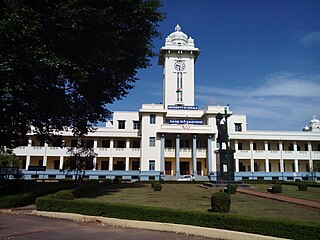
The importance and antiquity of education in Kerala is underscored by the state's ranking as among the most literate in the country. The educational transformation of Kerala was triggered by efforts of the Church Mission Society missionaries, who were the pioneers that promoted mass education in Kerala, in the early decades of the 19th century. The local dynastic precursors of modern-day Kerala—primarily the Travancore Royal Family, the Nair Service Society, Sree Narayana Dharma Paripalana Yogam and Muslim Educational Society (MES)—also made significant contributions to the progress on education in Kerala. Local schools were known by the general word kalaris, some of which taught martial arts, but other village schools run by Ezhuthachans were for imparting general education. Christian missionaries and British rule brought the modern school education system to Kerala.
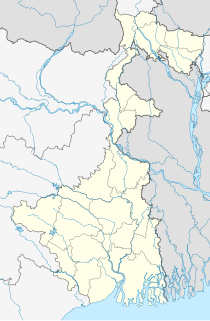
Kalyani subdivision is an administrative subdivision of the Nadia district in the Indian state of West Bengal.

As per the 2011 census of India, Andhra Pradesh has an overall literacy rate of 67.35%, significantly lower than the overall national average of 74.04%. Among the Indian states and union territories, it stands at 32nd position. During the same census, there are a total of 29,859,982 literates: 16,549,514 males and 13,310,468 females. In terms of district-wise literates, East Godavari has the most with 3,348,077 and Vizianagaram has the least with 1,238,388. While, in terms of district-wise literacy rates, West Godavari stands top with 74.32% and Vizianagaram at bottom with 58.89%. The government also implements fee reimbursement scheme for the economically backward sections of the state.
Education is based on three-tier model which includes primary schools, followed by secondary schools and tertiary education at universities or other institutes of same level. Education Department of the Government of Delhi is a premier body which looks into the educational affairs.the RTE right to education also describes children from the age of 6 to 14 have to cumpulsolarily need to be educated. 25% of the seats in all private schools are also reserved for the under-privileged children. Tertiary education is administrated by the Directorate of Higher Education.

Tamil Nadu is one of the most literate states in India. The state's literacy rate is 80.33% in 2011, which is above the national average. A survey conducted by the Industry body Assocham ranks Tamil Nadu top among Indian states with about 100% Gross Enrollment Ratio (GER) in primary and upper primary education.

Islampur is a community development block that forms an administrative division in Islampur subdivision of Uttar Dinajpur district in the Indian state of West Bengal.
Healthcare in Tripura features a universal health care system run by the state government. The Constitution of India charges every state with "raising of the level of nutrition and the standard of living of its people and the improvement of public health as among its primary duties". Ministry of Health & Family Welfare of the Government of Tripura is responsible for healthcare administration in the state.
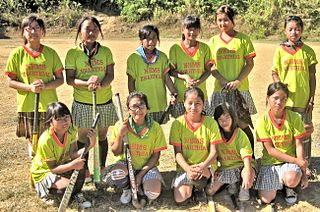
Education in Mizoram consists of a diverse array of formal education systems ranging from elementary to university, from training institution to technical courses. The Government of India imposes mandatory education at least up to the basic level. For this public schools are made free of fees, and provided with free textbooks and school lunch.
References
- ↑ "Tripura beats Kerala to become the Most Literate State in India". Biharprabha News. 8 September 2013. Retrieved 31 December 2018.
- ↑ "Economic review of Tripura 2010–11" (PDF). Directorate of Economics and Statistics, Planning (Statistics) Department, Government of Tripura. p. 231. Archived from the original (PDF) on 24 January 2013. Retrieved 20 April 2012.
- 1 2 "Boards of secondary & senior secondary education in India". Department of School Education and Literacy, Ministry of Human Resource Development, Government of India. Archived from the original on 20 March 2012. Retrieved 18 April 2012.
- ↑ "Economic review of Tripura 2010–11" (PDF). Directorate of Economics and Statistics, Planning (Statistics) Department, Government of Tripura. p. 232. Archived from the original (PDF) on 24 January 2013. Retrieved 20 April 2012.
- 1 2 "Economic review of Tripura 2010–11" (PDF). Directorate of Economics and Statistics, Planning (Statistics) Department, Government of Tripura. p. 233. Archived from the original (PDF) on 24 January 2013. Retrieved 20 April 2012.